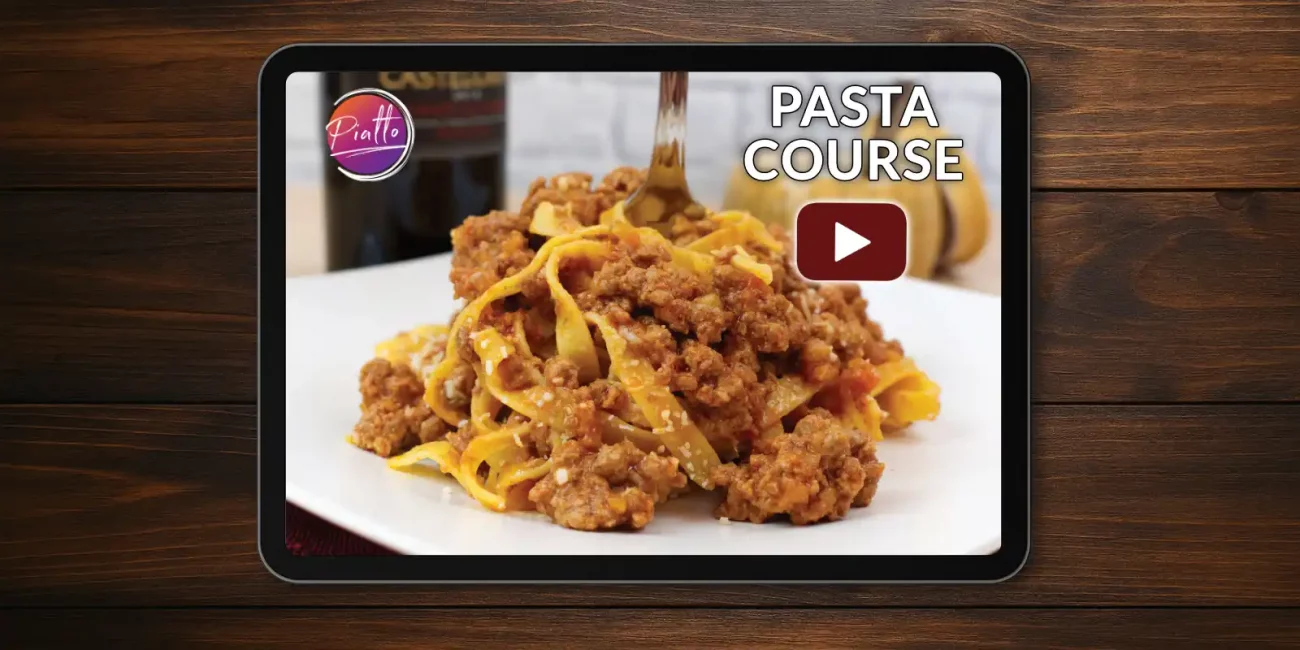Welcome to your free online Ragù Bolognese Pasta Course! This iconic sauce recipe from Bologna Italy has been codified twice—with the recipe updated very recently by the Bologna Chamber of Commerce. It’s a rich, slow cooked sauce packed with flavor and arguably the most famous ragù sauce recipe in Italy. The pasta? Fresh tagliatelle is the most traditional!
This course is part of our series of Free Online Italian Cooking Classes for Pasta, where we teach you to cook pasta like Italians do—from dough to dishes.
Video Class Overview
This lesson is filmed in stunning 4K for visual clarity, with subtitles available in English, French, Spanish, German, and other languages.
Each class is structured to walk you through the techniques used by Italian cooks—so you can see what matters (and what doesn’t) when making pasta the traditional way.
Ingredients and How to Make Ragù Bolognese Pasta
The full ingredient list and step-by-step instructions are below. We’ve formatted the recipe for easy saving or printing. Be sure to watch the video first—it covers essential technique tips!
We use the most traditional measurements and techniques, so you can recreate this recipe exactly as it would be made in Italy—no shortcuts, no substitutions unless noted.
Ragu Bolognese Tagliatelle Pasta Course
Ingredients
- 400 g ground beef shank or chuck roast "muscolo o cartella di manzo"
- 150 g fresh pancetta pork belly
- 60 g onion about a half
- 60 g carrot about one whole medium
- 60 g celery one rib
- 125 ml white or red wine use red!: one 'glass' (125 ml)
- 200 g tomato purée "passata"
- 1 tbsp triple concentrated tomato paste
- 125 ml whole milk one 'glass' 125 ml (optional but add it)
- 3 tbsp extra-virgin olive oil
- salt and pepper to taste
- 1 liter broth vegetable or beef to slow cook the ragù
- 600 g fresh tagliatelle pasta
Instructions
Make the Sauce
- Finely chop the pork belly/pancetta. Mince the onion, carrot and celery.
- Heat the oil in a large sauce pan or skillet.
- Sauté the vegetables until tender and translucent.
- Make a well in the center of the vegetables. Add the pancetta and cook until no longer red.
- Make a well and add the ground beef. Cook until no longer red.
- Slowly add the red wine a little at a time. Let the wine reduce and continue adding slowly until all of the wine has been added.
- Add the tomato puree and concentrated tomato paste. Stir. Cover and simmer on medium-low heat for 2-3 hours, adding ladles of broth as needed.
- After two hours, slowly add the whole milk over the course of an hour. Simmer over medium-low heat and stir frequently. Salt and pepper to taste!
- Combine the sauce with fresh tagliatelle pasta cooked to al dente. Buon appetito!
Equipment and Tools
You don’t need a professional kitchen to make great pasta—but the right tools can make it easier. For this recipe, we recommend:
- Large, well-insulated pot or skillet – this ragù is slow cooked so we want to use a pot that retains heat well.
- Meat grinder – if you’d like to grind the beef or pancetta yourself.
Video Class Overview
Is This Ragù Bolognese Pasta Recipe Traditional?
Yes—The official recipe for Ragù alla Bolognese was originally codified and deposited by the Chamber of Commerce in Bologna in 1982. Then, the Chamber recently decided the official recipe needed an update. Here’s the link to the new official recipe, which we are using in this Ragù Bolognese Pasta Course: https://www.bo.camcom.gov.it/it/blog/depositata-la-rinnovata-ricetta-del-vero-ragu-alla-bolognese
Pro Tips for Making Ragù Bolognese Pasta
Butter or Oil?
The original recipe codified by the Chamber of Commerce of Bologna in 1982 gave the option of butter or oil. The latest specifies olive oil.
Use a High Quality Broth
Broth is used over the long 2-3 hour cooktime to add flavor and prevent the sauce from burning. We always use quality broth—usually bone broth / beef stock we’ve made ourselves and frozen.
Spaghetti or Tagliatelle?
Fresh Tagliatelle is the pasta most commonly paired with Ragù Bolognese Sauce in Italy.
See our full article on Best Pasta Brands in Italy to learn more.
Check out our guide to making fresh tagliatelle!
Wine Selection
Always cook with a wine that you’d be willing to drink! Avoid wines marketed as ‘cooking wines’ as they are likely to be more acidic and lacking in flavor.
Make Big Batches and Freeze
This sauce has a relatively long cook time compared to other Italian pasta sauces. It’s a good idea to make big batches and freeze the sauce—it freezes wonderfully.
Common Mistakes to Avoid
Choosing Poor Quality Tomato Products
Many recipes from Ragù not coming from Italy include various ‘tricks’ to sweeten an otherwise acidic tomato sauce. The truth? If you choose high quality canned tomato products, you should have no need to ‘sweeten’ the sauce. Choose:
- purée and ‘passata’ products that say they are Made in Italy from San Marzano tomatoes
- avoid crushed or diced tomato tomato products which tend to contain skins, seeds and water that reduce the flavor and sweetness of the tomatoes
- avoid Cento ‘certified’ tomatoes which have been the subject of controversy over the way they market their tomato products
Learn more about choosing the best canned tomatoes for sauce in our guide!
Add the Milk
The official Ragù Bolognese recipes give the option, but we recommend you do add the milk to this sauce. It really rounds out the flavor and helps to further reduce any acidity coming from the tomato.
